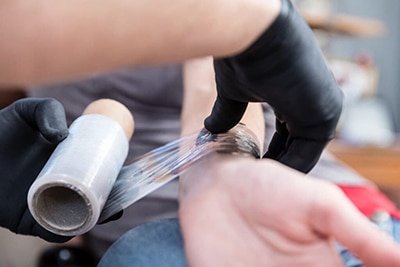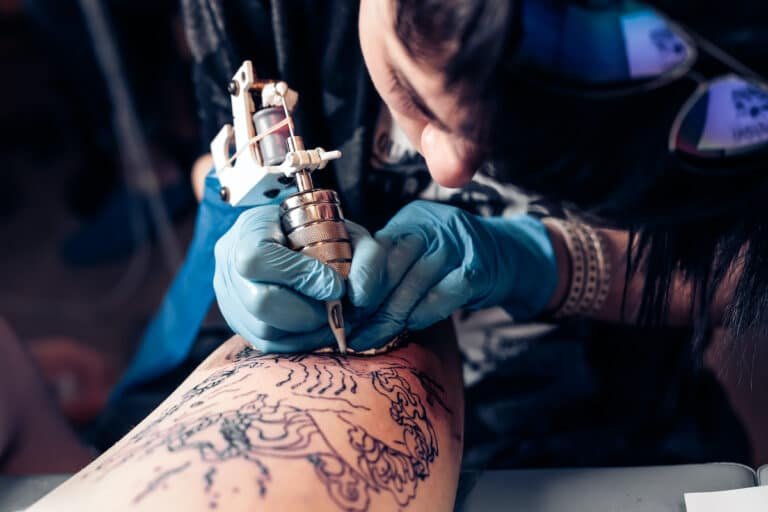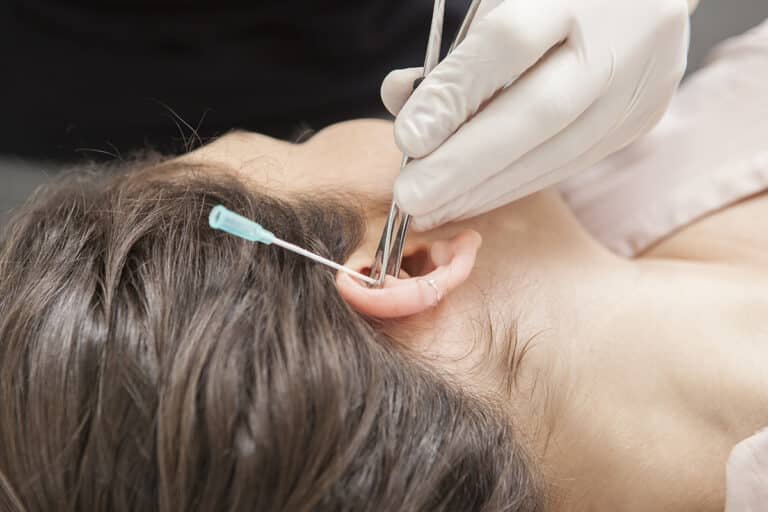During the tattoo healing process, a few things may occur that some people might find a little unsettling. These include the formation of scabs, peeling, and yes, even a bit of leakage. It’s not uncommon for individuals to notice their tattoo appearing to leak plasma, blood, ink, or even a combination of all three in the days following their fresh ink – whether it’s their very first tattoo or a new addition to their existing collection.
If the sight of plasma leakage from your tattoo has you concerned about potential infection, rest assured, you’re not alone. Witnessing this bodily fluid on what appears to be perfectly healthy skin understandably raises some worries.
However, here’s the good news – this particular symptom is generally deemed normal and nothing to be overly alarmed about. To delve into all the intriguing details surrounding why this happens and to learn when tattoo leakage of plasma might be cause for concern, simply read on.
So You’ve Got A Fresh Tattoo, What Now?
If you’ve just gotten a new tattoo, the healing process has already begun. One important element of the tattoo healing process is something called ‘plasma build up’, which is when your body creates a thin layer of plasma over the tattoo in order to protect it from external elements such as dirt and bacteria.
But What is Plasma and Plasma Build Up?
Simply put, plasma is a type of bodily fluid that contains proteins and salts in the form of water. It’s created by red blood cells, white blood cells, and platelets, and aids your body in a variety of ways such as helping to heal wounds and fight off infection.
Plasma build up helps protect them from these risks by forming a protective layer that is made up of several proteins and lipids. It’s the body’s natural way of stopping blood flow and protecting a new tattoo. When you get a tattoo, the needle creates microscopic wounds in the skin which are then filled with ink. These tiny wounds are vulnerable to bacteria and other contaminants that can make your new tattoo look dull or discolored over time.
What Does Plasma Build Up Look Like?
Plasma build-up often appears as a clear or slightly yellowish discharge that forms on the surface of your new tattoo. It can sometimes resemble a thin, wet sheen that coats the tattooed area, making it feel slick to the touch. In some cases, if the plasma dries before it’s cleaned, it can solidify into a thin crust on the tattoo. This is completely normal and is simply a part of your body’s natural healing process. It’s a clear indication that your body is doing its job to protect the newly inked skin and aid in its recovery.
How Long Should My Tattoo Be Leaking Plasma?
Your tattooed skin shouldn’t be leaking plasma for longer than a few days. If you are still experiencing your tattoo leaking plasma after this time period, it’s best to consult with your tattoo artist or a healthcare professional for further advice. Certain ointments can cause excessive plasma build up and potential infection. It is important to keep in mind that any kind of fluid coming from the skin can be a sign of infection and should not be ignored.
That’s all you need to know about plasma build up during the tattoo healing process! By understanding what it is, how it looks, and when it’s time to be concerned, you can rest easy knowing that your new ink is on track for a successful recovery.
How Can I Help My Tattoo Heal Quickly?
Your tattoo artist should have given you advice on how to care for your new tattoo over the next several weeks, but here are some general tips for tattoo aftercare:
- Keep the area covered with a fresh bandage and proper aftercare for the first few days
- Gently wash and moisturize the tattoo with a mild soap and warm water and let air dry
- Avoid direct sunlight, swimming pools, hot water, and extreme temperatures
- Don’t scratch or pick at the scabbing
- Wear loose clothing that won’t rub against the tattooed skin
By following these tattoo aftercare tips you can help ensure that your new tattoo heals correctly and quickly and help reduce the risk of a possible infection. Plasma build up is a normal part of the healing process for new tattoos, but it’s important to take care of it properly to keep your tattoo looking its best. Make sure to listen to the advice given by your tattoo artist for the best results and faster healing time, and you’ll be showing off your beautiful new ink in no time!
When Is My Tattoo Completely Healed?
Your tattoo will take around 4 to 6 weeks to completely heal. During this time it’s important to follow the tattoo aftercare instructions that you received from your tattoo artist in order to prevent any infection and keep your ink looking great. If you notice excessive plasma build up or other symptoms of infection, contact a healthcare professional right away!
How Do I Know if My Tattoo is Infected?
If the tattoo area is hot, swollen, and painful to touch or you notice a discharge that is a greenish or yellowish substance (which indicates infection), it’s important to seek attention from a medical professional right away. You should also watch for signs of fever such as chills, body aches, and a feeling of general ill health. These symptoms may indicate an infection that needs to be treated with antibiotics.
If you experience any of these at-risk signs while your tattoo is healing, don’t hesitate to contact your doctor for further instructions. Taking the necessary precautions can help protect both your skin and your overall health from potential harm.
Enjoy Your New Tattoo and Happy Healing!
When you notice any fluid leaking from your skin, it’s completely normal to feel a bit concerned. We’re accustomed to encountering leaking plasma only after experiencing a significant cut or wound, so it can be quite puzzling to see it emerge from seemingly unharmed skin. But rest assured that plasma build up is a natural part of the healing process for new tattoos and doesn’t usually indicate any cause for alarm.
Follow your aftercare instructions carefully and keep an eye out for potential infections, and you’ll be showing off your beautiful new ink in no time! Enjoy the healing process – it’s a reminder that your body is taking all the necessary steps to protect your newly inked skin. Here’s to a speedy recovery and lots of years with a colorful, vibrant tattoo!
Rad FAQ
Is fluid leaking from my fresh tattoo normal?
Yes, it is totally normal for fluid and excess ink to leak from your freshly tattooed skin. This fluid is called plasma and it is part of the body’s natural healing process. It forms a protective layer over the tattoo and helps keep dirt and bacteria away while also aiding in its recovery.
Why does my tattoo smell bad?
Your tattoo may smell bad due to a combination of the ink, plasma, and sweat. If you find that your tattoo has an unpleasant odor, it’s best to clean it with a mild soap and pat it completely dry using a clean towel or paper towel. Be careful not to use any harsh cleaners or scrubbing materials as this can cause irritation.
Can I put too much ointment on my new tattoo?
Yes, putting too much ointment on your tattoo can cause a build-up of plasma which can lead to possible infection. It is best to only apply enough ointment to keep the area moist but not wet.
Is a scabbing effect normal for a fresh tattoo?
Yes, a scabbing effect is normal for a new tattoo. However, if the scabbing becomes excessive or appears to be infected it’s important to contact your tattoo artist or a medical professional for further advice. Scratching or picking at the scab can damage the fresh ink and increase the chance of infection.
Can I take a bath with a new tattoo?
No, it is best to avoid soaking your new tattoo or any open wound in water as this can make the skin more prone to infection. It is recommended that you stick to showers and pat the area dry with a clean towel afterward. Avoid using hot water or scrubbing when cleaning the tattooed area as these methods can be harsh on your new ink.









